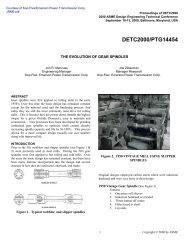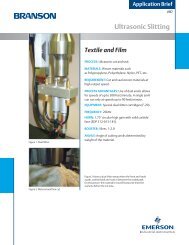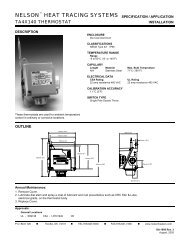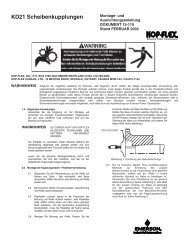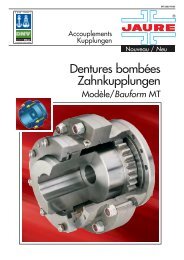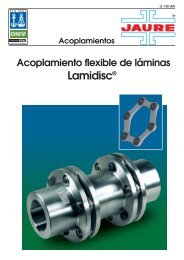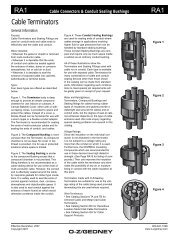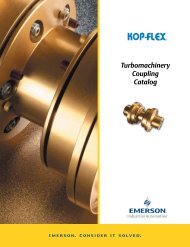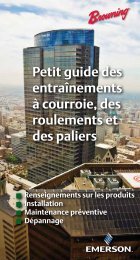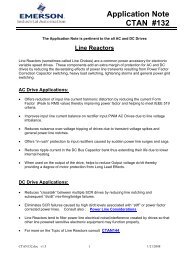Kop-Flex Industrial Coupling Product Catalog - Form 8887E
Kop-Flex Industrial Coupling Product Catalog - Form 8887E
Kop-Flex Industrial Coupling Product Catalog - Form 8887E
Create successful ePaper yourself
Turn your PDF publications into a flip-book with our unique Google optimized e-Paper software.
Design<br />
Gear spindles are available in four main configurations<br />
to solve the most difficult of applications, ranging from<br />
steel to aluminum to paper industries, usually in the<br />
main mill drive (Gearbox/Pinion to Roll, or Motor to Roll<br />
in direct drives):<br />
• LE and LB design: The largest lube capacity of<br />
any gear spindle design available in the worldwide<br />
market today, can increase the life of gearing, reduce<br />
replacement cost and minimize unscheduled<br />
down time - all for a large cost savings to the mill!<br />
• ME and MB design: Incorporates unique features<br />
that are not normally offered by others such as<br />
multiple lubrication ports, rising ring seal design,<br />
and many others.<br />
Material<br />
The physical capacities of a gear spindle depend on the<br />
material, heat treatment and the process used to finish<br />
the teeth after heat treatment.<br />
Many alloys are used to make spindles accommodate<br />
the combination of high torque and high operating<br />
misalignment and, in certain applications, high operating<br />
speed. The materials and heat treatments that are<br />
commonly used in mill spindle applications have relative<br />
strength, wear characteristics, and cost as shown in the<br />
following chart.<br />
The gear spindle design must balance these requirements<br />
to suit your specific application needs.<br />
Materials List<br />
1045 Carbon-Induction Hardened<br />
4140 Alloy-Nitrided<br />
Nitralloy-Nitrided<br />
Gear Spindles<br />
Main Drive Spindles<br />
Design and Materials<br />
Largest Lube Capacity<br />
Available in the<br />
LE and LB Design<br />
(LE Design Shown)<br />
4320 Alloy-Carburized<br />
3310 Alloy-Carburized<br />
Every installation has its own requirements for strength,<br />
core ductility, resistance to shock, wear surface lubricity,<br />
and case depth. KOP-FLEX designs maximize material<br />
benefits while minimizing cost. The following guide is a<br />
general recommendation.<br />
Medium duty cold, temper, tube and bar mills<br />
AISI 4140<br />
• Heat treated and tempered for improved strength.<br />
• Nitrided gearing, providing high surface hardness to<br />
resist wear and heat generation. Surface hardness<br />
of about 54 to 58 R c<br />
. (BHN)<br />
High speed cold mills and hot strip finishing mills<br />
AISI 4140 or Nitralloy<br />
• Heat treated and tempered for maximum strength.<br />
• Nitrided gearing, providing high surface hardness to<br />
resist wear and heat generation. Surface hardness<br />
of about 54 to 65 R c<br />
. (BHN)<br />
This material provides a superior wear surface and<br />
a lower coefficient of friction. Less friction means<br />
less heat generation. Applications that combine high<br />
speeds and relatively high misalignment, such as<br />
high speed cold mills and hot strip finishing mills,<br />
cause high pressure-velocity (PV) values. High PV<br />
generates excessive heat which causes lubrication<br />
breakdown as well as tooth spalling and wear.<br />
Hot strip and roughers<br />
AISI 8620, AISI 4320, or AISI 9310/3310<br />
• Carburized, quenched, and tempered, providing<br />
a deep hard case and high strength over a ductile<br />
shock resistant core. Core Hardness of 300 to 360<br />
BHN.<br />
• Surface finished by machine lapping or profile grinding<br />
of both the internal and crowned flank external<br />
gear to reduce distortion from carburizing. Surface<br />
hardness of about 58-65 R c<br />
after lapping or grinding.<br />
This provides maximum tooth contact for extended<br />
operating life.<br />
197





